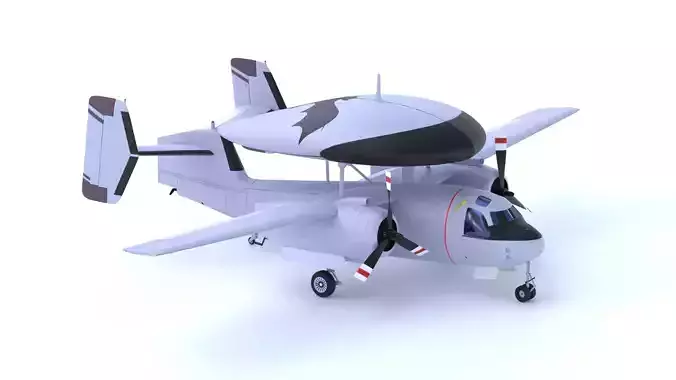1/41
Perfect for use in games and simulation projects.
The Grumman E-1 Tracer was a landmark in naval aviation history, serving as the first purpose-built airborne early warning (AEW) aircraft operated by the United States Navy. Developed during the height of the Cold War, it was derived from the Grumman C-1 Trader, itself a variant of the S-2 Tracker, and officially entered service in 1958. The E-1 Tracer was designed to meet a critical need: to provide early detection and tracking of enemy aircraft, particularly Soviet bombers and interceptors, at a time when radar coverage from surface ships was still limited by the curvature of the Earth. Unlike earlier AEW aircraft that had been modified from existing airframes, the E-1 was engineered from the outset for the AEW role, featuring a unique large radome mounted on its fuselage and folding wings for ease of storage aboard aircraft carriers.
Central to its capabilities was the Hazeltine AN/APS-82 radar system, which featured a then-novel Airborne Moving Target Indicator (AMTI). This system allowed the radar to distinguish moving aerial targets from background clutter caused by wave action on the sea’s surface. By comparing the position and strength of radar reflections over successive pulses, the AMTI system could accurately detect and track enemy aircraft, providing vital situational awareness far beyond the reach of ship-based radar. The E-1 had an operational detection radius of 250 to 300 miles, significantly enhancing the U.S. Navy's ability to defend carrier strike groups in contested environments. Though powered by piston engines and limited in speed and altitude compared to more modern designs, the Tracer’s advanced electronics made it a valuable asset during its nearly two-decade career.
During the Vietnam War, the E-1 Tracer played a critical role in the coordination and control of aerial combat operations. It was deployed aboard Essex-class and Midway-class aircraft carriers, where it served as a command and control platform for Combat Air Patrol (CAP) fighters. E-1B variants were responsible for vectoring friendly fighters toward incoming North Vietnamese MiGs and warning strike aircraft of enemy activity during large-scale bombing missions, referred to as Alpha strikes. Operating at a distance from the carrier group, the Tracer served as the fleet's distant eyes, tracking hostile aircraft and relaying data to interceptors and strike commanders in real time. This role was especially vital during the early and mid-1960s, when North Vietnam’s air defenses were rapidly expanding in capability and coordination.
Despite its effectiveness, the E-1 Tracer was always considered a stopgap measure. The Navy was already developing a more advanced platform: the Grumman E-2 Hawkeye, which featured turboprop engines, a rotating radome, and significantly more advanced avionics and radar capabilities. The Hawkeye began replacing the E-1 in the mid-to-late 1960s, gradually assuming the AEW mission across all U.S. carrier groups. Nonetheless, the Tracer remained in active service well into the 1970s, with the last operational units assigned to VAW-121 based at Naval Air Station Norfolk. The final deployment occurred aboard the USS Franklin D. Roosevelt, and by mid-1977, the last remaining Tracers were retired and ferried to the aircraft storage facility at Davis-Monthan Air Force Base in Arizona.
By the time it was struck from the Navy inventory in 1977, the Grumman E-1 Tracer had cemented its place as a pioneering platform in naval AEW doctrine. Though modest in appearance and capabilities by today’s standards, it laid the technological and tactical groundwork for the more advanced systems that followed. For game developers and simulation designers, the E-1 Tracer offers a compelling combination of Cold War-era technology, tactical importance, and visual distinctiveness. Its integration into carrier operations, reliance on analog systems, and role in one of the most intense periods of U.S. naval aviation make it an ideal asset for historically grounded military simulations, alternate history scenarios, or Cold War strategy games.
Formats include: OBJ, FBX. Feel free to check out the other models, just click on the user name to see the complete portfolio.
REVIEWS & COMMENTS
accuracy, and usability.









































